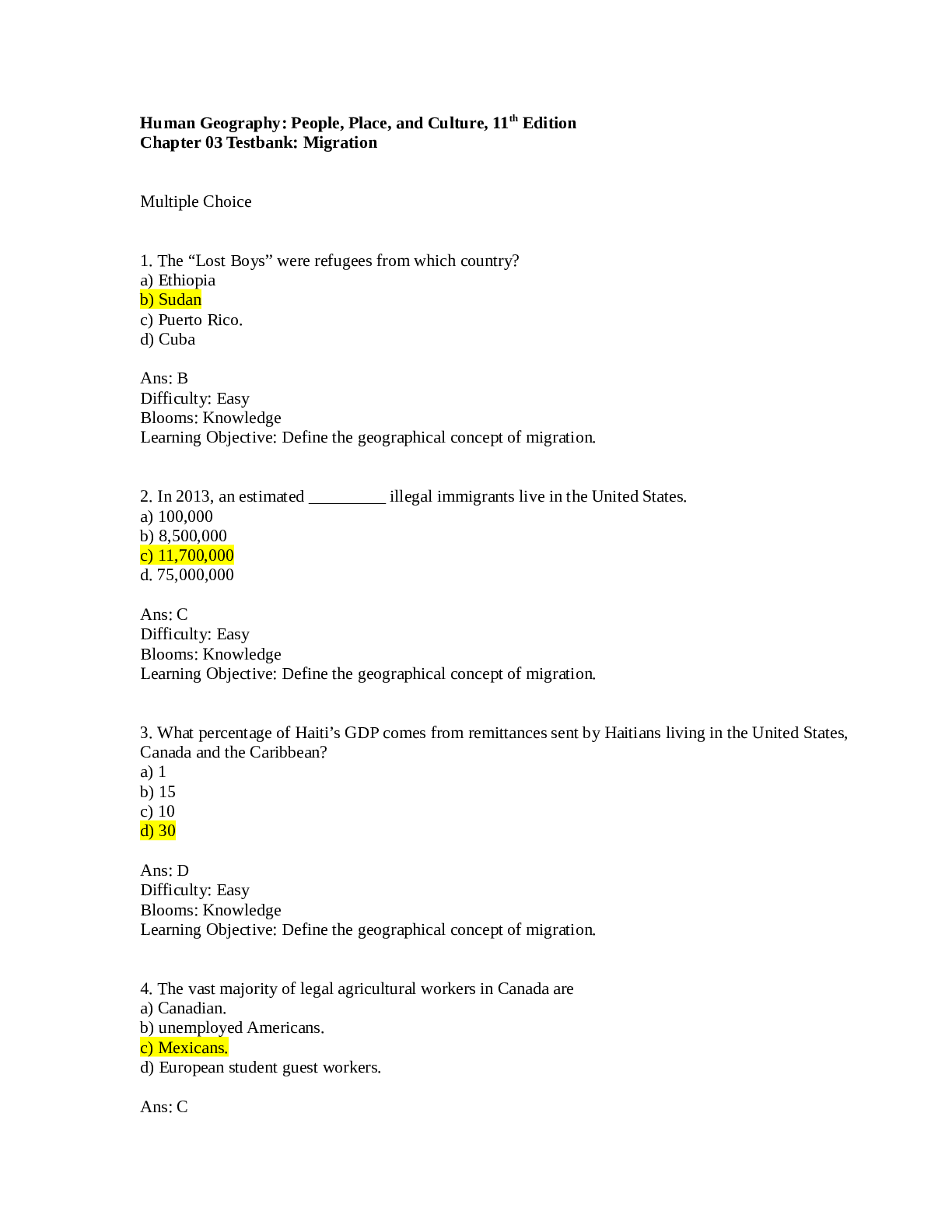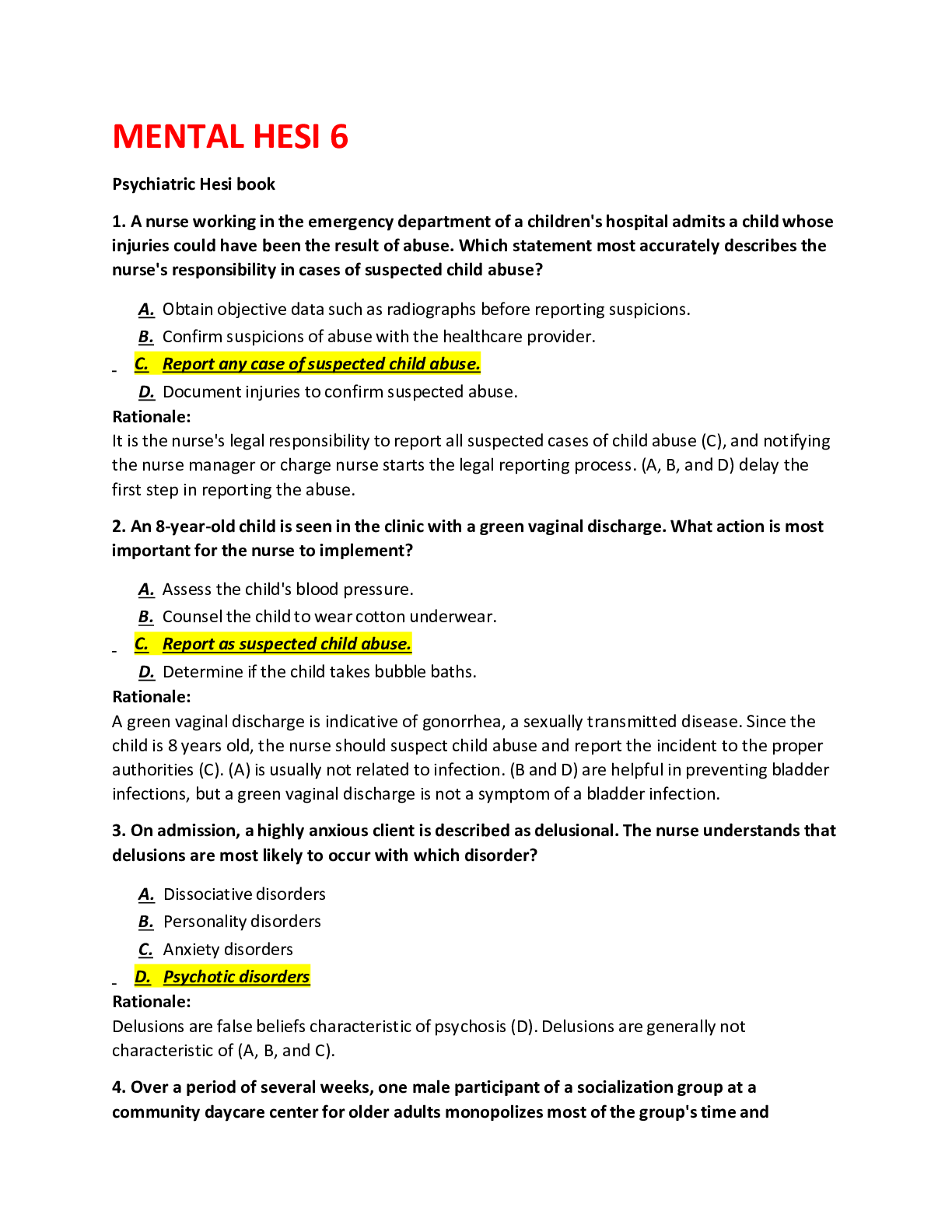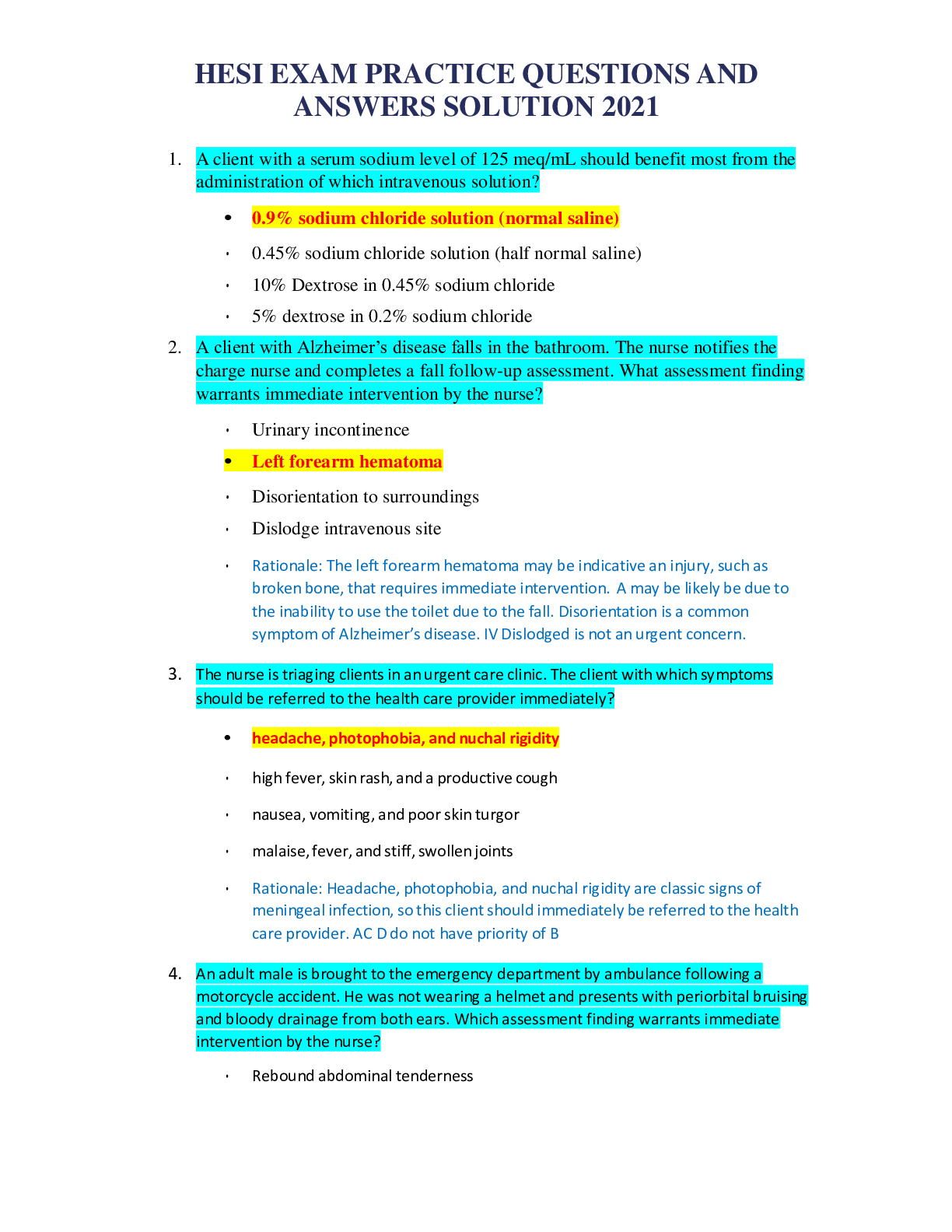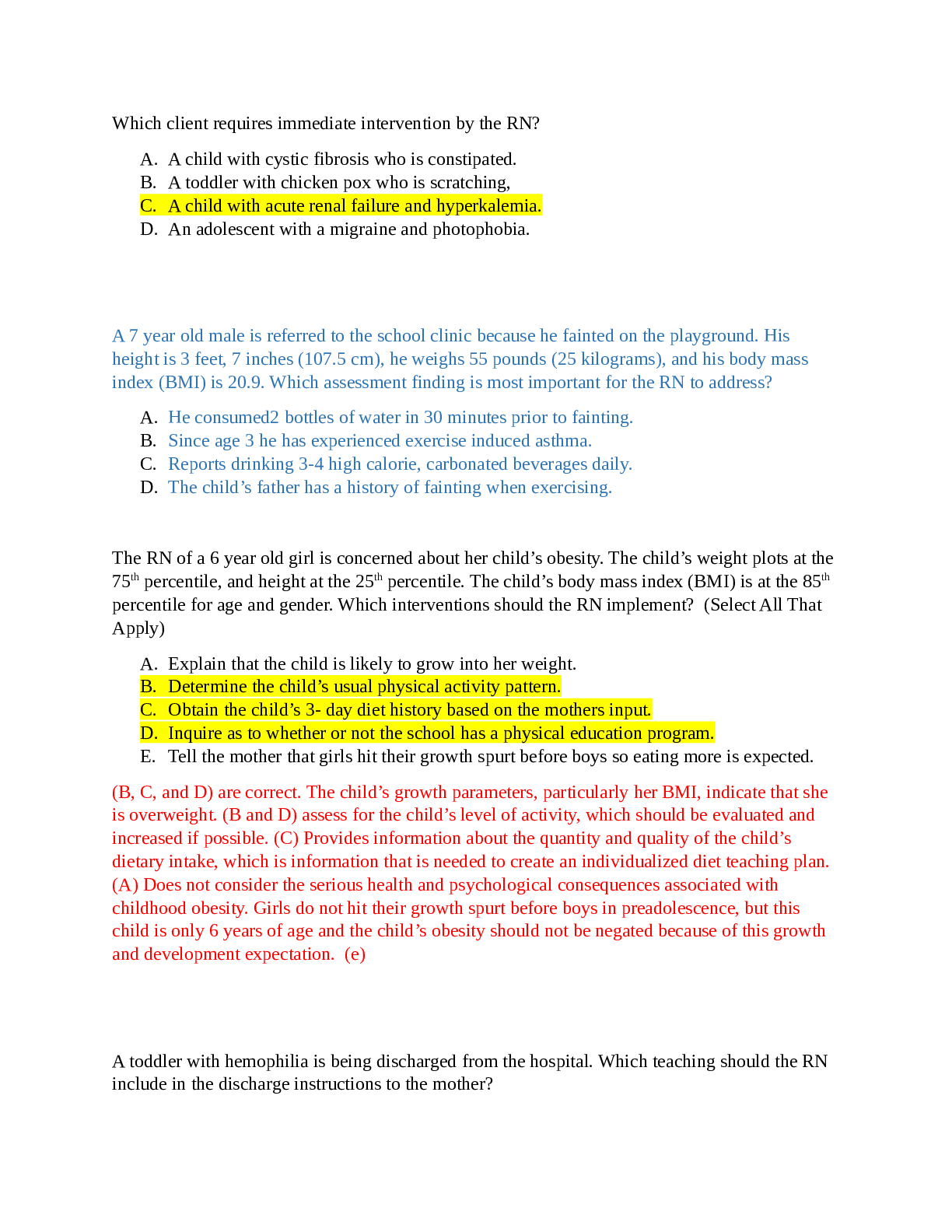Geography > HESI > Testbank: Migration _ Human Geography: People, Place, and Culture, 11th Edition (All)
Testbank: Migration _ Human Geography: People, Place, and Culture, 11th Edition
Document Content and Description Below
Human Geography: People, Place, and Culture, 11th Edition Chapter 03 Testbank: Migration Multiple Choice 1. The “Lost Boys” were refugees from which country? a) Ethiopia b) Sudan c) Pu... erto Rico. d) Cuba 2. In 2013, an estimated illegal immigrants live in the United States. a) 100,000 b) 8,500,000 c) 11,700,000 d. 75,000,000 3. What percentage of Haiti’s GDP comes from remittances sent by Haitians living in the United States, Canada and the Caribbean? a) 1 b) 15 c) 10 d) 30 4. The vast majority of legal agricultural workers in Canada are a) Canadian. b) unemployed Americans. c) Mexicans. d) European student guest workers. 5. The type of movement that involves journeys that begin at and bring us back to our home base is called a) periodic. b) immigration. c) migratory. d) cyclic. 6. More than 5,000,000 legally immigrated to the U. S. between 1980 and 2012. a) Mexicans b) Haitians c) Jamaicans d) Colombians 7. Commuters in Washington, DC may travel up to miles each way to work daily. a) 5 b) 10 c) 25 d) 100 8. Most nomadic movement takes place according to travel patterns that are a) repeated time and time again. b) very irregular. c) limited to desert regions. d) periodic in nature. 9. Which of the identified types of movement creates your activity space? a) periodic b) migratory c) cyclic d) emigration 10. All of the following are examples of periodic movements except a) going to college. b) transhumance. c) commuting to work. d) migrant workers. 11. A periodic form of movement that involves a system of pastoral farming whereby livestock and their keepers adjust their location to the seasonal availability of pastures is called: a) nomadic herding. b) transhumance. c) livestock farming. d) ranching. Ans: B Difficulty: Easy Blooms: Knowledge Learning Objective: Define the geographical concept of migration. 12. A common form of periodic movement involving several million Americans is a) summer camp. b) vacations. c) military service. d) sabbatical leaves. 13. The long-term relocation of an individual, household, or group to a new location outside the community of origin is called a) resettlement. b) emigration. c) migration. d) transmovement. 14. During the first decades of the twentieth century, African American families in the United States migrated primarily to a) the north. b) the west. c) the northwest. d) other southern states farther west. 15. Which US states experienced highest percent change during the period 2010-2012 a) Louisiana, Alabama, Pennsylvania b) Texas, Colorado, Utah c) Wyoming, Maryland, Maine d) Wyoming, Illinois, Maryland 16. In the United States during the late twentieth century, internal migration streams were moving people from a) west to east and south to north. b) west to east and north to south. c) east to west and south to north. d) east to west and north to south. 17. Internal migration in Peru is fairly simple with the majority of migrants moving to a) Iquitos on the Amazon. b) Ecuador. c) Lima. d) new farmland in rural areas. 18. Irish migration to North America in the mid-1800s is an example of a) forced migration. b) migration which reflects both forced and voluntary aspects of migration. c) voluntary migration. d) cyclical migration. 19. Gender studies of migration indicate that men than women. a) are more mobile b) migrate farther c) have more employment choices and income d) all of the above 20. The smallest number of slaves involved in the Atlantic slave trade was sent to a) British Caribbean. b) Brazil. c) French Caribbean. d) British North America. 21. Which of the following is not one of Ernst Ravenstein’s laws of migration? a) Every migration flow generates a return or counter-migration. b) Urban residents are less migratory than inhabitants of rural areas. c) The majority of migrants move short distances. d) The majority of urban migrants are uneducated. 22. Between 1788 and 1838, tens of thousands of convicts were shipped from Britain to which of the following continents? a) Africa b) North America c) Australia d) Asia 23. One of the “laws” of migration as derived by Ravenstein states that a) urban residents never migrate. b) rural residents are less migratory than urban. c) urban residents are less migratory than rural. d) rural inhabitants hardly ever migrate. 24. Ravenstein, in his study of migration, suggested that there is an inverse relationship between the volume of migration and the distance between the source and destination. That is, the number of migrants as the distance they know they must travel increases. a) increases b) decreases c) remains the same d) decreases and then rises 25. What is the model which states that spatial interaction between places (e.g. migration) is directly related to the population size and inversely related to the distance between them? a) gravity model b) model of emigration c) distance decay model d) intervening opportunity model 26. According to Ravenstein, migrants who move longer distances tend to choose a) warmer destinations. b) open “frontier” areas. c) big-city destinations. d) to migrate as a family unit. 27. What push factor compelled more than 50,000 Asians to leave Uganda in 1972? a) It was too hot and crowded. b) Food was in short supply. c) Uganda’s economy collapsed. d) Ugandan leader Idi Amin expelled them. 28. Chain migration occurs when: a) The migrant uses technology to find a job in a new place. b) The migrant finds another opportunity along the way to the intended destination. c) The migrant travels with large numbers of other migrants. d) The migrant travels to a place because of communications with family and friends already living in the destination. 29. Of the 10,000 inhabitants of the Caribbean island Montserrat, 7,000 have left the island and the remaining 3,000 have moved to the north coast of the island because of a) hurricanes. b) the collapse of the banana economy. c) volcanic eruptions. d) civil war. 30. European migration to colonies reached its peak during this period: a) 1700-1800. b) 1800-1835. c) 1835-1935. d) post World War II. 31. British colonial authorities stimulated migration of people from this region to colonies such as Singapore and Trinidad. a) Africa b) South Asia c) Europe d) South America 32. European colonialism stimulated the movement of to the cities (islands of development) of Southeast Asia where they have become a significant minority population. a) Africans b) Central Asians c) Europeans d) Chinese 33. Major routes of human migration before 1950 include all of the following except: a) eastern United States to western United States. b) China to the United States. c) Europe to Australia. d) China to India. 34. Major islands of sub-Saharan development have occurred in: a) South Africa and Nigeria. b) Somalia and Sudan. c) South Africa and Angola. d) Congo and Ethiopia. Ans: A Difficulty: Medium Blooms: Application Learning Objective: Identify the routes of major migration flows over the past 500 years. 35. Major concentrations of Chinese immigrants are found in all of the following places except: a) Java. b) southern Malaysia. c) East Timor. d) southern Vietnam. 36. There are between 50,000 and 80,000 refugees that have fled from to Lebanon since 2011. a) Iran b) Syria c) Sudan d) Turkey 37. In 2010, the center of the U.S. population was located in: a) Missouri. b) Ohio. c) Indiana. d) Illinois. 38. A person who has a well-founded fear of being persecuted for reasons of race, religion, nationality, membership of a particular social group, or political opinion is officially a: a) patriot b) refugee c) displaced person d) gypsy 39. In terms of total number of refugees, is the geographic realm most severely affected by refugee problems. a) Russia b) Central America and the Caribbean c) South America d) North Africa and Southwest Asia 40. The intervention of what country in the civil war beginning in 1979 in Afghanistan caused great numbers of refugees to leave the country? a) India b) the Soviet Union c) the United States d) Pakistan . 41. One recent refugee crisis in Southwest Asia took place in 1991, when, in the aftermath of the Gulf War, the population of northern Iraq was forced to leave their villages and flee across the Turkish and Iranian borders. a) Christian b) Kurdish c) Indian d) Jewish 42. The Afghan Taliban (Islamic fundamentalists) movement, spawned in Pakistan, created a counter migration of 2.5 million Afghanis to when they came to power. a) Pakistan b) Russia c) India d) Iran 43. In recent years, the largest numbers of internally displaced persons in Southeast Asia are reported from a) Cambodia. b) Myanmar (Burma). c) Vietnam. d) Laos. 44. In 1990’s, the collapse of which of the following European countries produced the largest refugee crisis in Europe since the end of World War II? a) Turkey b) Yugoslavia c) Greece d) Romania 45. Recently, the country with the greatest number of IDP’s in the western hemisphere was a) Brazil. b) Colombia. c) Jamaica. d) Haiti. 46. Which is not an example of a fortified barrier to migration? a) the United States - Canadian border b) the Great Wall of China c) the Berlin Wall d) fences along the Rio Grande River 47. In the period from 1882-1907, the United States Congress passed exclusionary immigration laws designed to keep out of the immigrant stream. a) Irish b) Mexicans c) Chinese d) Russians 48. The practice of excluding people with criminal records, health problems, or subversive political beliefs from immigrating is referred to as a) selective immigration. b) prejudice. c) asylum refusal. d) chain migration. 49. Since September 2001, there has been a greater concern about immigration control to a) illegal immigrations impact on unemployment rates. b) the spread of infectious diseases. c) interrupt drug trafficking. d) prevent terrorism. 50. Post September 2001, asylum seekers from 33 countries where operates were automatically were automatically detained by the US government. a) ISIS b) Hezbollah c) FARC d) Al-Qaeda Ans: D Difficulty: Easy 51. Israel has occupied the Sinai Peninsula since 1967. 52. More than 5,000,000 Mexicans legally immigrated to the United States between 1980-2012. 53. All of the following stimulated migration: Hurricane Katrina, the eruption of Soufriere Hills Volcano, and the Irish famine of the 1840’s. . 54. Nomadism is a type of cyclical movement. 55. Transhumance movement usually occurs in urban areas. 56. Texas and North Dakota both experienced population increases of greater than 3% from 2010-2012. 57. As a result of the Atlantic Slave Trade from 1702-1810, most African slaves ended up in North America. 58. Australia prohibited immigration by non-whites until the 1970’s. 59. In the years 2000-2009, more Asians immigrated to the U.S. than Europeans. 60. In recent decades, major internal migrations in the United States are toward the Sunbelt and western states. Ans: True Difficulty: Easy Blooms: Knowledge Learning Objective: Define the geographical concept of migration. 61. Transhumance involves the permanent movement of populations across major mountain range boundaries (e.g. the Andes between Chile and Argentina). 62. Pull factors are the conditions or perceptions which help a migrant to decide to leave a place. 63. The US Department of State’s annual Trafficking-in-Persons (TIP) report identified 40,000 human trafficking victims in the US... 64. Recent European immigration has included North Africans to France and Turks to Germany. 65. When migrants move along or through kinship links, this is called chain migration. 66. The map of modern migrations shows a movement from European Russia east toward the Pacific and southeast into Central Asia. 67. Internal migration of Huichol Indians to northern Mexican agricultural regions is a recent development in Mexico’s internal migration pattern. 68. Sri Lanka has never experienced significant refugee problems. 69. Very few countries practice selective immigration. 70. Define cyclic movement and periodic movement. Give examples (perhaps, from your own experience) of each. Describe your own activity space. 71. Look at the map (figure 3.10). Choose three numbered migrations and describe the migrations by type, by who was involved, and the period and consequences of the migration. 72. Discuss the geography of the refugee problem. Discuss the difference between internal and international refugees and give examples of each type. 73. Define push and pull factors and discuss, with examples, the various types of push and pull factors. 74. What are some of the economic, social, and security issues involved in the debate over United States immigration policy? Describe the several categories of migrants (legal, illegal, temporary worker, refugee etc.) currently residing in the United States. [Show More]
Last updated: 1 year ago
Preview 1 out of 18 pages

Buy this document to get the full access instantly
Instant Download Access after purchase
Add to cartInstant download
We Accept:

Reviews( 0 )
$13.00
Document information
Connected school, study & course
About the document
Uploaded On
Mar 13, 2021
Number of pages
18
Written in
Additional information
This document has been written for:
Uploaded
Mar 13, 2021
Downloads
0
Views
38



.png)




.png)




